Do-it-yourself flushing of the well after drilling: step-by-step briefing on the work
Owners of suburban real estate will have to face drilling wells in their own area, since there is simply no other way to organize a water supply system at home. Agree, this is a fairly responsible event, which needs to be taken seriously.
Do not forget that in order to get clean water from the well, it must be freed from the particles of soil drawn to the bottom immediately of the drilling process. Therefore, flushing the well after drilling is necessary in all cases. You can clean the output yourself, using the necessary equipment and having some knowledge about this process.
Next, we will talk about the most common methods of flushing wells and how to do it yourself. In addition, you will learn what mistakes should be avoided during the course of work. The material is accompanied by photo illustrations and videos that clearly demonstrate the flushing of wells.
The content of the article:
Why flush a well after drilling?
After graduation well drilling process needs to be flushed so that the recovered water meets sanitary and hygienic requirements.
The fact is that the contaminants that make the water unsuitable for use, in large quantities fall into the mouth during development. Also, debris, small insects, etc. can get on top during drilling.
If you neglect washing and immediately install the filters, they will quickly become clogged and deteriorate, and a silt layer will form at the bottom, which will become a source of unpleasant taste and smell.
In addition, pathogenic microorganisms reproduce very well in the mud layer, which means that drinking water from such a well will be hazardous to health.
The mud layer will increase over time and completely block access to the aquifer. Well operation will become impossible.These problems can be easily avoided and prolong the life of your source by flushing it immediately after drilling.
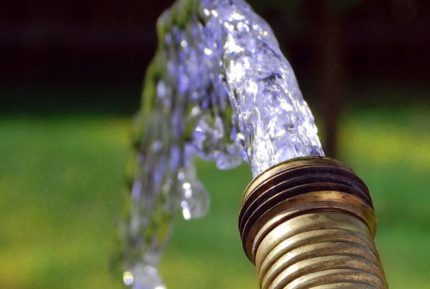
Reasons for flushing the well:
- improving the quality of produced water;
- extending the life of pumping equipment, filters;
- increase well productivity;
- increased operational life, open access to the aquifer.
Flushing the well before commissioning can be done with your own hands, without the involvement of specialists.
This is not a very complicated process, if you know the technology and the features of its implementation.
The best ways to flush wells
In total, there are four ways to flush the well after drilling. Each method is carried out using various equipment and devices.
The choice of this or that method depends on many factors: the depth of the well, the type of soil, the degree of contamination, the nature of the contamination, the materials from which the borehole columns are made.
Four ways to flush a well:
- using a pump;
- using two pumps;
- by blowing airlift;
- manual method using a bobbin.
Flushing manual way - labor-intensive and ineffective method, which can be applied in the presence of a small siltation of a shallow well, located on clay and loamy stable soils.
Air purge requires the use of special industrial equipment - a high-power compressor.
Few private owners have the opportunity to use such equipment. Therefore, the best way to clean the well before putting it into operation is flushing with pumps.
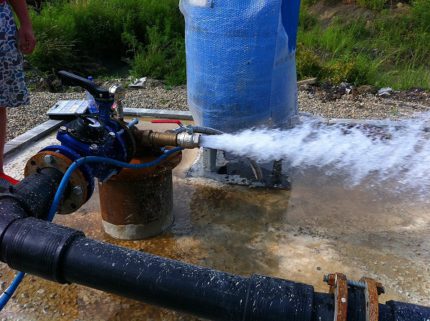
Regarding the flushing technology, two methods are distinguished:
- straight;
- back.
Direct flushing - a method in which water is supplied inside using a flushing hose, as a result of which contaminants exit through the hole in the well.
Direct flushing is used to remove heavy sediment remaining after drilling.
Backwash - a method in which water enters the annulus, while the upward flow along with the impurities is discharged out through the pipe. This method of washing is effective when cleaning from sand and non-hard mud deposits.
Sometimes chemical reagents are used to flush wells, it is advisable to do this in the presence of iron-containing impurities. The cost of such reagents is quite high, so in most cases ordinary technical water is used to clean the well.
Method # 1. Flushing a well with one pump
This is the easiest way to flush, for the implementation of which you need:
- submersible pump;
- discharge hose;
- cable.
In this case, the flushing of the well is carried out due to the pumped out water, which will carry away pollution. The duration of such pumping can be from 12 hours to several days, depending on the degree of contamination. You can stop cleaning when the water extracted from the well is not clean.
Submersible Pump Selection
Well flushing will be effective only if the right submersible pump is selected.
Requirements for the pump:
- optimal power;
- low price.
When washing the well after drilling, the pump experiences heavy loads, pumping cubic meters of contaminated water. Therefore, the probability of failure of the pump is very high.
In other words, it is recommended to use a pump that is “not a pity” for flushing the well. This can be a very cheap model or an old, exhausted pump, which has long been in need of replacement.
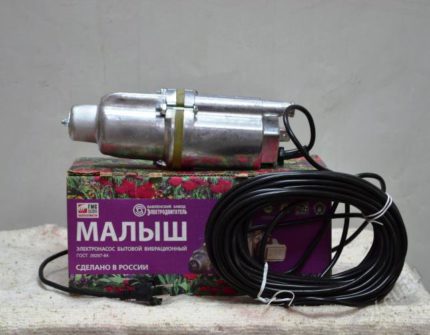
The best option would be to use a vibrating submersible pump. Often they use affordable aggregates for work: "Kid" or The trickle.
Such pumps are less sensitive to silt particles and sand, unlike centrifugal pumps.
The principle of flushing with a vibration pump is as follows: after connecting the device to power supply, a magnetic field is generated inside its body, which constantly either amplifies or weakens.
The created reciprocating movements (vibration) lead to a change in pressure, due to which water is pumped.
The advantages of submersible vibration pumps include:
- low cost;
- ease of use;
- lack of heating during operation.
Disadvantages of pumps of this type:
- Cannot work stably at “jumping” voltage in the power supply network;
- low power in comparison with centrifugal pumps.
Of course, the use of a more powerful centrifugal or screw pump will allow the well to be cleaned much faster.
However, the cost of even the simplest submersible pumps of these types is several times higher than that of vibration pumps. And given that, with a high degree of probability, the pump will be unsuitable for well operation in the future, the use of vibrational submersible equipment will be the most acceptable option.
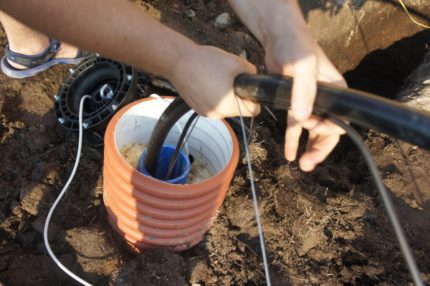
Recommendations for choosing a pump for cleaning wells are given in this article.
Production technology
A step-by-step instruction for flushing the well after drilling is as follows:
- The submersible pump is securely attached to the cable to prevent it from being drawn into the sludge. It is not recommended to use the rope or cord included in the kit. their strength is not always enough to pull the pump out of the silt “trap”.
- The pump descends to the very bottom of the well and rises several times in a row. This is done to agitate the sediment at the bottom.
- At a certain height, the pump is suspended and connected to the mains. The location of the pump is determined above the bottom of the source by 60-80 cm. In no case should the working pump be lowered to the very bottom!
- The pump pumps the well until the water is clear.
Please note that in some cases, water from the well will be ejected under high pressure, so measures must be taken to protect the surrounding landscape from dirt emissions.
In order for the pump to wear out less, it is necessary to periodically remove it to the surface and rinse with clean water. Rinsing frequency - every 5-6 hours.
Advantages of the method of flushing a well with a single pump: simplicity and high efficiency. This method is also used for well pumping, commissioned or already used source of water intake.
The disadvantages of this method include the fact that in most cases it takes a long time to flush, and there is also a risk of breakdown of the pumping equipment. This method is advisable to apply on sandy and sandy loamy soils.
To increase the quality and speed of washing, you can use a higher submersible pump centrifugal type.
Also fecal and drainage pumpspassing through itself during pumping particles with fractions up to 30-40 mm.
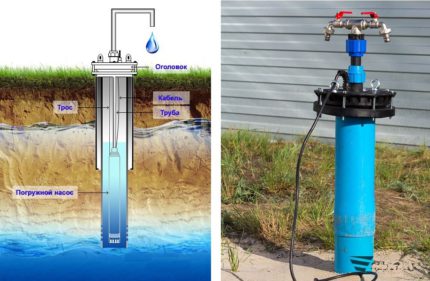
Method # 2. Use of two pumps
In this case, the flushing is carried out using the water pumped into the well by the first pump, where it “collects” contaminants and, using the second pump, raises them to the surface in the water tank.
A filter is installed in the tank, which cleans the incoming liquid from suspended particles and returns it back to the well for a new portion of contaminants.
To flush a well in this way, you will need:
- a water tank with a volume of at least 200 l;
- submersible vibration pump (pump No. 1);
- centrifugal pump (pump No. 2);
- bucket with drilled holes for installing the pump;
- two hoses;
- strong cable.
When implementing this method, the submersible pump experiences a lower load, which means that the risk of its failure decreases. This method is advisable to apply in the case when it is planned to further operate the submersible pump, as well as with a limited amount of clean (suitable for washing) water.
Flushing using two pumps is as follows:
- Submersible pump No. 1 is lowered into the well with a cable and suspended 50-60 cm from silt deposits.
- An injection hose is lowered into the water tank, a second hose is lowered from the tank into the well.
- A centrifugal pump No. 2 is installed in the bucket and immersed in the tank.
- Both pumps turn on, while the hose located in the well must be shaken in different directions for maximum erosion of deposits.
- Flushing lasts until the water being washed out of the well becomes clear.
When flushing, it is worthwhile to focus on a more powerful pump, it should be stopped periodically to maintain an optimal water level in the tank.
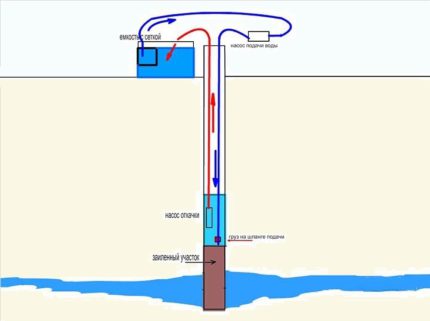
Advantages of the flushing method using two pumps:
- faster and better flushing;
- less load on the submersible pump;
- the area around the well is not contaminated;
- not a lot of water is required.
The main disadvantage of this method is the need to constantly be present during flushing in order to control the coordination of the operation of both pumps, sometimes turning off the more powerful one.
The duration of well cleaning after drilling with this method is from 6 hours to 48 hours.
Method # 2. Flushing the well with airlift
Airlift is a special device that produces a powerful stream of compressed air that raises water from the bottom of the well along with sand, debris and silty sediments. To flush a well with an airlift, a filter must be installed inside it, through which it is cleaned of suspended particles.
Equipment necessary for flushing a well after drilling by airlift method:
- air compressor (air blower);
- stock of technical water 100-200 l;
- metal pipe;
- air hose.
The pipe is taken to the entire depth of the well, and its diameter should be 10-15 cm less than the diameter of the casing. A narrow pipe will not work, because will not provide effective cleaning.
The upper part of the pipe must have a branch for the removal of contaminants. In order to prevent mud from splashing the area adjacent to the well, a tight polyethylene sleeve or part of a rubberized fire hose must be put on the end of the pipe.
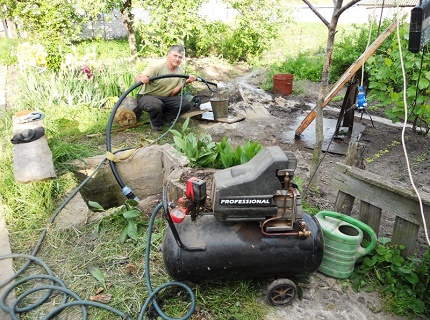
The principle of airlift operation is that the volume of air is pumped through the pipe into the well, and then it is pushed out from there under the influence of water pressure, washing away all contaminants.
The procedure for flushing the well after drilling using airlift:
- A metal pipe of the required diameter is placed in the well. The pipe is immersed as much as possible in silt deposits.
- An outlet and outlet hose are mounted on the upper end of the pipe to prevent dirt from splashing.
- The compressor turns on and the compressed air enters the well under pressure.
- Bubbles of air, being in the pipe, set in motion water and sludge mass at the bottom, creating its circulation.
- Under the influence of compressed air, water, together with contaminants, flies up to the outlet and is removed through the outlet hose.
Flushing is considered to be completed when particles of silt, sand and debris cease to flow from the discharge hose. This method is quite effective and does not require the use of pumping equipment.
When cleaning with airlift, it must be taken into account that too much air pressure can adversely affect the integrity of the borehole walls.
It is also worth considering that this method is quite energy-consuming - the compressor unit consumes a lot of electricity, and the washing time can be up to 24 hours.
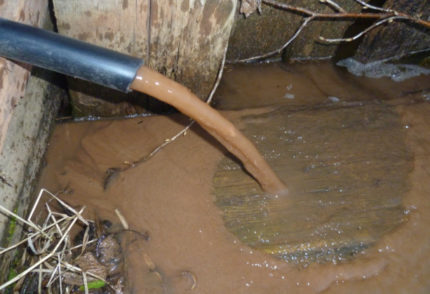
The advantages of this method include: a short duration of the washing process, the pump equipment does not deteriorate, the area around the well is not contaminated, and the washing quality is high.
Common flushing errors
Inexperienced well owners often make mistakes by ignoring flushing the well after completion of drilling operations. As a result, the water in the production remains untreated, which makes its use limited.
Error number 1. One of the most common mistakes when flushing a well with a pump is its incorrect suspension height.
The pump must not be allowed to touch the bottom, in which case the cleaning will not be effective: the pump will not be able to trap silty particles under its body. As a result, sludge will remain at the bottom of the well, blocking access to the aquifer and impairing water quality.
In addition, a too low position of the pump can lead to equipment “burrowing” into the sludge and getting it out of there will be problematic. It also happens that the pump gets stuck in the wellbore.
This can be avoided if a thin but strong cable is used for immersion, and when pulling the pump back, do not make sudden movements, and gently rocking the cable lift the pump out of the well.
Mistake # 2. Improperly organized drainage. Contaminated water coming from the well should be diverted as far as possible from the wellhead.
Otherwise, there is a risk that it will again fall into the source, which will lead to an increase in the washing time, and hence additional financial costs. For the organization of water disposal, it is best to use durable fire hoses.
It is important to flush the well before it receives clean water. Putting an unwashed well into operation is prohibited! This will lead to damage to the pumping equipment and problems. well operation in future.
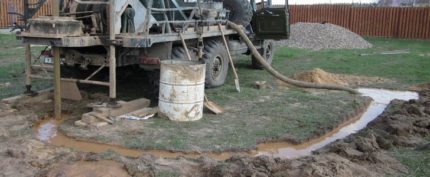
Conclusions and useful video on the topic
Flushing a well with a pump:
What does the process of flushing the well with one pump look like and why it is necessary to take care of the organization of water disposal:
As you can see, flushing a well after completion of drilling operations is a necessary measure that cannot be dispensed with if you want to get clean water.
There are several ways to flush: one or two pumps or airlift. It is not practical to use the manual cleaning method with the batch for primary washing because of its low efficiency.
Have something to supplement, or have questions about the topic? Share your experience with the flushing of the well with readers, please leave comments on the publication. The contact form is located in the lower block.

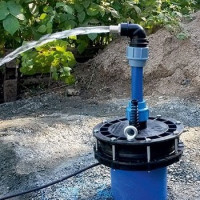 How to swing a well: methods for pumping after drilling and during operation
How to swing a well: methods for pumping after drilling and during operation 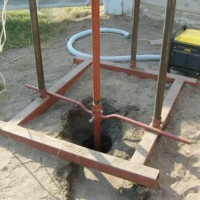 DIY water well: arrangement rules + analysis of 4 popular drilling methods
DIY water well: arrangement rules + analysis of 4 popular drilling methods 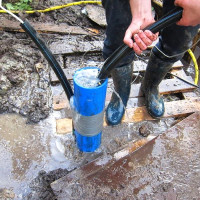 Do-it-yourself well cleaning: a review of common clogging causes and best cleaning methods
Do-it-yourself well cleaning: a review of common clogging causes and best cleaning methods 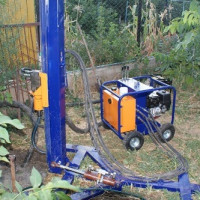 Do-it-yourself water-boring for water wells: a review of technology
Do-it-yourself water-boring for water wells: a review of technology 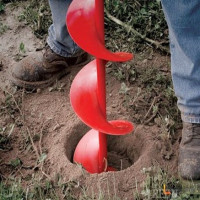 How to drill a well with your own hands: ways to budget independent drilling
How to drill a well with your own hands: ways to budget independent drilling 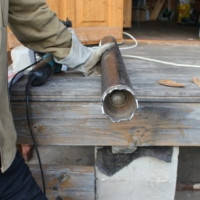 Well bumper: device, options and do-it-yourself manufacturing schemes
Well bumper: device, options and do-it-yourself manufacturing schemes  How much does it cost to connect gas to a private house: the price of organizing gas supply
How much does it cost to connect gas to a private house: the price of organizing gas supply  The best washing machines with dryer: model rating and customer tips
The best washing machines with dryer: model rating and customer tips  What is the color temperature of light and the nuances of choosing the temperature of the lamps to suit your needs
What is the color temperature of light and the nuances of choosing the temperature of the lamps to suit your needs  Replacement of a geyser in an apartment: replacement paperwork + basic norms and requirements
Replacement of a geyser in an apartment: replacement paperwork + basic norms and requirements
Please tell me, is it necessary to flush the well every day? Just before you get water to drink, we let a minimum of 2 minutes of water go to idle. Or we recruit it for watering seedlings, and then for drinking. Is it possible to install special filters directly into the well so that there is no doubt that the water is clean and whether the properties of the water depend on the depth of the wells?
The well is washed once - after drilling. And they are not washed for 2 minutes, but for a long period, until the moment when it becomes suitable for drinking. I know people who pumped for several weeks without turning off the pump.
Water filters immersed in the well, of course, exist, and there are quite a lot of them. Starting from a simple gravel filter that prevents dirt from being taken up to a bunch of different membrane filters.Normal filters are made by Honeywell and Drufi, although others can be found. In a good way, you need to conduct a laboratory analysis of water to determine what degree of purification it needs and then it is already determined with a filter.
What is the average amount of time it takes to pump a well? Our soil is clayey.
It would be nice if you indicated not only the type of soil, but also the depth of the well. Because based on only data on the type of soil, it is impossible to give an answer for the specific dates that are necessary for a full pumping of the well. In the most difficult case, it is about two days. It all depends on the thickness of the silted area, which will be washed. The process may take several hours, or it may take a couple of days.
I also advise you to conduct a chemical analysis of water! Many people for some reason believe that this is not necessary, but because of this there are various unpleasant cases that adversely affect health.